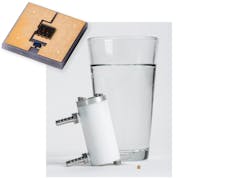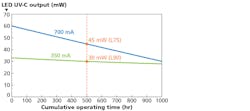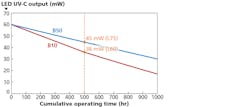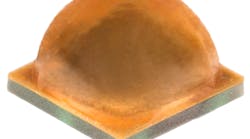EOIN CONNOLLYexplains how application usage scenarios impact the specification and design of UV-C-based sterilization and disinfection products and that common measures of LED lifetime can be misleading.
Ultraviolet (UV) LEDs have a bright future in industrial and life science applications even given the fact that humans can’t see the light. In particular, LEDs in the UV-C band (generally 100–280 nm) promise to revolutionize sterilization and disinfection and could bring safe water to people around the globe and safer conditions to our medical facilities (Fig. 1). LEDs Magazine, in fact, covered a Crystal IS LED designed for such an application earlier this year. Still, we hear that such applications need LEDs with higher performance and longer lifetimes to truly penetrate the market. But UV product developers need to rethink LED lifetime as another variable in the engineering process.
FIG. 1. UV-C LEDs such as the device pictured above can be designed into compact water purification systems like the one shown here, enabling safe water at the point of use (POU).
Without question, “What is your product lifetime?” is a common inquiry heard by UV-C LED manufacturers from engineers considering an LED-based UV-C source for disinfection. It’s typically prompted by current design experience with traditional UV-C sources, like low-pressure germicidal lamps, or perceptions of visible LED products. But there is an immediate disconnect. LED lifetime is not a fixed specification. It is a variable factor that engineers can control after considering how the UV-C LED will be used.
In Asian point-of-use (POU) water markets, a real and genuine concern for the microbial quality of tap water is spurring explosive growth for countertop and portable consumer and commercial water purification products. Both startups and established brands are looking to capitalize on this trend. Startups, driven by a need for innovation and differentiation and without the legacy bias toward germicidal lamps, tend to move directly to evaluate and adopt UV-C LEDs.
For decades, established water purifier OEMs have relied on low-pressure germicidal lamps to provide proven UV disinfection. However, in August 2017, the Minimata Convention on mercury entered into force with the stated goal of phasing out mercury in everyday products. Some have speculated that in the future, manufacturing companies may be financially responsible for the disposal costs of mercury used in their products. These potential regulatory barriers, consumer preference for nontoxic products, and the competitive pressure from startups provide strong motivation for established water purifier OEMs to consider UV-C LEDs.
Rethink lifetime relative to operating hours
Low-pressure germicidal lamps traditionally used in these markets are typically associated with lifetime claims of 8000 to 10,000 hours. So it is understandable why engineers would ask or expect that UV-C LEDs achieve similar or longer lifetimes. However, when looking at the lamp specifications, this lifetime is only achievable with a limited on/off cycle rate. For example, it is typical to see germicidal lamps used in commercial water purification applications operating continuously, with annual lamp replacement to ensure reliable disinfection performance. Where low-pressure germicidal lamps are frequently and intermittently cycled, such as in a consumer appliance, designers expect to achieve less than 50 hours of lifetime. As with the continuous 24/7 example, lamps must be replaced annually to ensure reliable disinfection performance.
As a solid-state device, UV-C LEDs can be cycled on/off tens of thousands of times with little or no observable difference or degradation in performance. UV-C LEDs also offer a near-instant capability to provide full rated output, requiring no warmup time. These abilities mean that LEDs can be employed in an on-demand fashion, accumulating operating hours only when “on” and providing their disinfection function without penalty.
Engineers considering next-generation products that avoid annual lamp replacement without sacrificing reliable disinfection performance will routinely ask whether UV-C LEDs can achieve 25,000, 40,000 or even 100,000 hours. However, upon understanding the on-demand capabilities of UV-C LEDs, conversation quickly shifts to considering actual use cases for these systems.
For example, while commercial POU systems — like a soda dispenser — may be plugged in all the time, they typically perform less than 200 hours of actual water purification per year. Over the typical five-year product lifespan of a commercial water purification system, a low-pressure germicidal lamp would require five lamp replacements while constantly remaining on, consuming energy and generating waste heat. In contrast, an LED system would likely last the full five years and accumulate fewer than 1000 hours of use.
In the case of consumer markets, typical POU systems are sized to provide up to 6000 liters of purified water a year. With a bottle or glass filling rate of 2 to 4 liters per minute, this equates to annual LED operation of 25 to 50 hours. Over the 10-year lifetime of a typical consumer appliance, a low-pressure germicidal lamp solution would require 10 lamp replacements. In contrast, an LED-based system would operate for the full lifetime of the appliance and accumulate less than 500 hours of use.
Disinfection in air and on surfaces
Infection prevention is a banner cry by many epidemiologists concerned with reducing instances of healthcare-acquired infections (HAIs) and combating the growing threat of superbugs. Antimicrobial resistance is becoming a pressing issue as it results in drugs becoming ineffective and requiring increasingly harsher chemicals for surface disinfection. In this market, UV-C light has a proven track record being used to address air purification as far back as the early 1900s. In fact, there are instances of UV-C lamps still being employed for air purification in communal locations like waiting rooms, where sick patients interact with other patients and clinical care workers, thereby increasing the risk of developing multiple co-morbidities.
In the US, the Centers for Disease Control and Prevention (CDC) has reported real improvements in controlling the incidents of HAIs while at the same time noting that that there is still much work to do. As a result, medical equipment providers are considering how UV-C provides infection prevention and control in portable devices which could be used by healthcare professionals at the point-of-care or to disinfect high touch surfaces, like personal electronics, medical carts, and diagnostic equipment.
The focus on portability places a premium on technologies that are compact, lightweight, can be battery powered, and can withstand on-demand use. Since low-pressure germicidal lamps fall short on many of these requirements, medical equipment design engineers see that UV-C LEDs represent a natural fit. A challenge here is that adding UV-C to portable medical equipment is novel to many OEMs and easily-found online research is based on visible LED characteristics.
Prioritize UV-C LED output over lifetime
With visible LEDs, consumers generally recognize long lifetime as the primary value. In fact, the EPA Energy Star guideline requires a visible LED lifetime greater than 25,000 hours, and industry standards (IES LM-80 and TM-21) require LED providers to test products for a minimum of 6000 hours in order to make a lifetime claim.
As with visible LEDs, a UV-C LED by its very nature is a constant-current device. As the forward current applied to the diode is changed, the UV-C output of the diode increases or decreases in a proportional manner. In addition, the UV-C output of an LED degrades overtime. The rate of degradation varies with both the particular UV-C LED and the operating conditions. Principal among these are temperature (LEDs degrade slowly at lower temperatures, more rapidly at high temperatures); forward current (slowly at lower drive currents, more rapidly at higher drive currents); and material properties. By balancing these factors, designers can build systems that prioritize output over lifetime or vice versa.
FIG. 2. UV-C output of an LED over time based on different operating currents at an ambient temperature of 35°C.
Fig. 2 shows a sample LED output over time (hours) when operated at two different forward-current levels. At 350 mA, a typical specified condition by UV-C LED manufacturers, the LED emits an initial output of 33 mW in radiometric power and shows little degradation over 1000 hours of use. In contrast, when operated at 700 mA, the LED may emit close to 60 mW but degrades quickly under this condition.
So how should we define or prioritize lifetime? One common reference to specify end of life for a UV-C LED is the point at which the radiometric output has degraded to some percentage of its initial value. This metric is expressed as an “L-value.” Flux-maintenance life is measured in hours — the notation L50 is often used to describe an average flux-maintenance behavior and would imply a decline in output by 50% relative to initial performance. Other L-values such as L70 are often common practice.
FIG. 3. At 500 hours, the UV-C output and percentage of original UV-C output (L-value) varies based on the drive current of the device.
Fig. 3 illustrates that when the aforementioned LED is operated at 700 mA, it has an L75 life of 500 hours — meaning that the LED produced 75% (45 mW) of the initial UV-C output (60 mW) at 500 hours. In contrast, when operated at 350 mA the LED has an L90 of 500 hours — meaning that the LED produced 90% (30 mW) of the initial output (33 mW) at 500 hours.
It is important to understand how this data informs product design. For example, a chamber to deliver surface disinfection to a cell phone or stethoscope in a healthcare setting requires high pathogen reduction (6-log of E. coli) in times under 30 seconds. If operated 30 times a day, every day, an LED system would be used 92 hours per year and less than 500 hours in a typical five-year product lifetime.
In this case, achieving a higher dosage with higher UV-C intensity in 30 seconds is the application priority over an inflated lifetime requirement. By understanding the cumulative operating time and comparing this with the LED characteristics, a design engineer could decide to operate the LED at 700 mA to provide 50% higher UV-C output than if operated at 350 mA.
Proving UV-C LED reliability
Of course, development engineers must also consider the inherent differences in performance and lifetime from component to component. Any sample set of LEDs will exhibit a natural statistical distribution in their degradation rate for a given forward current and temperature condition. The percentage of samples in a population that degrade below a defined target is denoted by the B-value — the notation B50 is often used to describe an average lifetime behavior. Fig. 4 provides the behavior of different LEDs based on B values of a population. The blue line shows that at 500 hours, under the specific operating conditions, 50% of a sample population (the average) will emit 45 mW while 50% of the sample population will emit something less than 45 mW.
In many applications, whether due to market risks in healthcare or cost pressures to reduce the number of LEDs integrated in POU water systems, understanding how 50% of a population will behave is insufficient. It is imperative to assign a clear confidence level for achieving the disinfection claim for the full lifetime of the product. Design engineers reduce the probability for LED degradation below the target by looking at performance at a lower B value, like the red line in Fig. 4. This data shows that at 500 hours, only 10% of devices in a sample population emit less than 36 mW of their initial output — which is the L60B10 value.
FIG. 4. UV-C output for a population of devices operated at a drive current of 700 mA with an ambient temperature of 35°C. The graph shows the population data for reliability values of B50 and B10.
Lifetime metrics and cumulative operating hours
Whether as a disinfection source for POU water or as a portable point-of-care medical device, achieving reliable disinfection for the full lifetime of the product is spurring UV-C LED adoption. This is more than achievable within the typical on-demand operation for these applications. However, using traditional lifetime metrics employed in visible LEDs can mislead engineers away from fundamentally required attributes and direct attention to characteristics which may be completely contradictory in terms of how to select, use, and compare UV-C LED products.
By revealing how both the forward current and thermal configuration of the device can be controlled to achieve specific product lifetime goals, system design engineers can tailor UV-C LED operation to achieve required performance over a defined lifetime for the lowest cost. Thus, in the context of on-demand disinfection systems, UV-C LED lifetime is more usefully defined as the cumulative operating hours until the UV-C LED reaches the end of its reliable useful life.
Measure lifetime in real-world conditions
As OEMs for water purifiers and medical devices evaluate UV-C LEDs for a range of applications from countertop to portable units, it becomes important to show relevant end-of-life performance under real-world application conditions rather than lifetime under ideal conditions.
As solid-state devices, UV-C LEDs can address a diverse range of operating conditions and offer the ability to adjust output and lifetime parameters to perform tens of thousands of on/off cycles for on-demand use. It is critical that end-of-life conditions be specified clearly in terms of both L-value and B-value. Doing this with the right application-based thermal conditions is also key so the number of LEDs employed in a product reflects the desired outcome for achieving the end-of-life performance target.
To answer the original question of “What is your product lifetime?” start by building awareness that LED lifetime is an output variable — one over which the product developer has some control. It’s determined by environmental requirements, operating conditions, and UV-C LED product characteristics — it is not a standardized input. The real question is not “What is your product lifetime?” but “What lifetime do you need to achieve?”
EOIN CONNOLLY is vice president of product management at Crystal IS.










